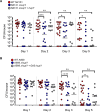Transcriptomic Analysis of Streptococcus pyogenes Colonizing the Vaginal Mucosa Identifies hupY, an MtsR-Regulated Adhesin Involved in Heme Utilization
- PMID: 31239377
- PMCID: PMC6593403
- DOI: 10.1128/mBio.00848-19
Transcriptomic Analysis of Streptococcus pyogenes Colonizing the Vaginal Mucosa Identifies hupY, an MtsR-Regulated Adhesin Involved in Heme Utilization
Abstract
Streptococcus pyogenes (group A streptococcus [GAS]) is a serious human pathogen with the ability to colonize mucosal surfaces such as the nasopharynx and vaginal tract, often leading to infections such as pharyngitis and vulvovaginitis. We present genome-wide transcriptome sequencing (RNASeq) data showing the transcriptomic changes GAS undergoes during vaginal colonization. These data reveal that the regulon controlled by MtsR, a master metal regulator, is activated during vaginal colonization. This regulon includes two genes highly expressed during vaginal colonization, hupYZ Here we show that HupY binds heme in vitro, affects intracellular concentrations of iron, and is essential for proper growth of GAS using hemoglobin or serum as the sole iron source. HupY is also important for murine vaginal colonization of both GAS and the related vaginal colonizer and pathogen Streptococcus agalactiae (group B streptococcus [GBS]). These data provide essential information on the link between metal regulation and mucosal colonization in both GAS and GBS.IMPORTANCE Colonization of the host requires the ability to adapt to an environment that is often low in essential nutrients such as iron. Here we present data showing that the transcriptome of the important human pathogen Streptococcus pyogenes shows extensive remodeling during in vivo growth, resulting in, among many other differentially expressed genes and pathways, a significant increase in genes involved in acquiring iron from host heme. Data show that HupY, previously characterized as an adhesin in both S. pyogenes and the related pathogen Streptococcus agalactiae, binds heme and affects intracellular iron concentrations. HupY, a protein with no known heme binding domains, represents a novel heme binding protein playing an important role in bacterial iron homeostasis as well as vaginal colonization.
Keywords: Streptococcus; adherence; colonization; heme; iron uptake.
Copyright © 2019 Cook et al.
Figures







Similar articles
-
A Vaginal Tract Signal Detected by the Group B Streptococcus SaeRS System Elicits Transcriptomic Changes and Enhances Murine Colonization.Infect Immun. 2018 Mar 22;86(4):e00762-17. doi: 10.1128/IAI.00762-17. Print 2018 Apr. Infect Immun. 2018. PMID: 29378799 Free PMC article.
-
A Novel Heme Transporter from the Energy Coupling Factor Family Is Vital for Group A Streptococcus Colonization and Infections.J Bacteriol. 2020 Jun 25;202(14):e00205-20. doi: 10.1128/JB.00205-20. Print 2020 Jun 25. J Bacteriol. 2020. PMID: 32393520 Free PMC article.
-
Identification of Key Determinants of Staphylococcus aureus Vaginal Colonization.mBio. 2019 Dec 24;10(6):e02321-19. doi: 10.1128/mBio.02321-19. mBio. 2019. PMID: 31874913 Free PMC article.
-
Virulence factor regulation and regulatory networks in Streptococcus pyogenes and their impact on pathogen-host interactions.Trends Microbiol. 2003 May;11(5):224-32. doi: 10.1016/s0966-842x(03)00098-2. Trends Microbiol. 2003. PMID: 12781526 Review.
-
Two-Component Signal Transduction Systems in the Human Pathogen Streptococcus agalactiae.Infect Immun. 2020 Jun 22;88(7):e00931-19. doi: 10.1128/IAI.00931-19. Print 2020 Jun 22. Infect Immun. 2020. PMID: 31988177 Free PMC article. Review.
Cited by
-
The Regulatory Protein ChuP Connects Heme and Siderophore-Mediated Iron Acquisition Systems Required for Chromobacterium violaceum Virulence.Front Cell Infect Microbiol. 2022 May 11;12:873536. doi: 10.3389/fcimb.2022.873536. eCollection 2022. Front Cell Infect Microbiol. 2022. PMID: 35646721 Free PMC article.
-
Native Human Antibody to Shr Promotes Mice Survival After Intraperitoneal Challenge With Invasive Group A Streptococcus.J Infect Dis. 2021 Apr 23;223(8):1367-1375. doi: 10.1093/infdis/jiaa540. J Infect Dis. 2021. PMID: 32845315 Free PMC article.
-
Virulence and pathogenicity of group B Streptococcus: Virulence factors and their roles in perinatal infection.Virulence. 2025 Dec;16(1):2451173. doi: 10.1080/21505594.2025.2451173. Epub 2025 Jan 23. Virulence. 2025. PMID: 39844743 Free PMC article. Review.
-
Engineered Liposomes Protect Immortalized Immune Cells from Cytolysins Secreted by Group A and Group G Streptococci.Cells. 2022 Jan 5;11(1):166. doi: 10.3390/cells11010166. Cells. 2022. PMID: 35011729 Free PMC article.
-
Phosphotransferase System Uptake and Metabolism of the β-Glucoside Salicin Impact Group A Streptococcal Bloodstream Survival and Soft Tissue Infection.Infect Immun. 2020 Sep 18;88(10):e00346-20. doi: 10.1128/IAI.00346-20. Print 2020 Sep 18. Infect Immun. 2020. PMID: 32719156 Free PMC article.
References
-
- Hamburger M Jr, Green MJ, Hamburger VG. 1945. The problem of the dangerous carrier of hemolytic streptococci; spread of infection by individuals with strongly positive nose cultures who expelled large numbers of hemolytic streptococci. J Infect Dis 77:96–108. doi:10.1093/infdis/77.2.96. - DOI - PubMed
-
- Erdem G, Sinclair S, Marrone JR, I'Atala TF, Tuua A, Tuua B, Tuumua F, Dodd A, Mizumoto C, Medina L. 2010. Higher rates of streptococcal colonization among children in the Pacific Rim region correlates with higher rates of group A streptococcal disease and sequelae. Clin Microbiol Infect 16:452–455. doi:10.1111/j.1469-0691.2009.02879.x. - DOI - PMC - PubMed
Publication types
MeSH terms
Substances
Grants and funding
LinkOut - more resources
Full Text Sources
Medical
Molecular Biology Databases

